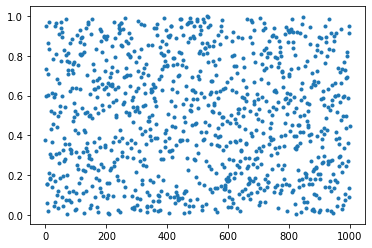Random numbers
Week 1 homework
- Non-runnable code
- I edited the notebook, -2 penalty
- Make sure you leave all code syntactically valid
- Dot in filename: Please don't do this
- Docstring: Many of you forgot (I will only require something that specific if I specifically request it in the problem)
- Return values: A function should "return" whatever it is asked to produce
- Some confusion about lists vs. length of lists
A word about Magics
Project plans
Friday is project selection day! We'll go over the possible projects then. You'll have a little time to think about it before selecting one. Please send me or post on Blackboard your project selection ideas!
We'll be discussing setting up project files (instead of just using notebooks) on that day too, probably.
Cheat sheets
Posted on Blackboard.
import numpy as np
import matplotlib.pyplot as plt
def lin_cong(c, a, M, r_i):
return (a * r_i + c) % M
lin_cong(c=1, a=4, M=9, r_i=3)
lin_cong(c=1, a=4, M=9, r_i=4)
def iterator():
yield 1
yield 2
yield 3
for item in iterator():
print(item)
tuple(iterator())
def lin_cong_iter(c, a, M, r_0):
r_i = r_0
while True:
yield r_i
r_i = lin_cong(c, a, M, r_i)
if r_i == r_0:
return
list(lin_cong_iter(1, 4, 9, 3))
list(i / 8 for i in lin_cong_iter(1, 4, 9, 3))
Try it out:
Set a=57, c=1, M=256, r_0=10 (like in the book) and see what happens.
vals = list(lin_cong_iter(a=57, c=1, M=256, r_0=10))
print(len(vals))
real_rand = np.random.randint(0, 256, 256)
fig, axs = plt.subplots(1, 2, figsize=(12, 4))
axs[0].plot(vals[::2], vals[1::2], "+")
axs[1].plot(real_rand[::2], real_rand[1::2], "+")
plt.show()
fig, axs = plt.subplots(1, 2, figsize=(16, 4))
axs[0].plot(range(256), vals, "x-")
axs[1].plot(range(256), real_rand, "x-")
plt.show()
import random
random.seed(42)
for i in range(10):
print(random.randint(0, 256))
np.random.seed(42)
np.random.randint(0, 256, 10)
state1 = np.random.RandomState(42)
state1.randint(0, 256)
np.random.seed(42)
rsamp = np.random.rand(1000)
rsamp[:100]
plt.plot(rsamp, ".")
N = len(rsamp)
moment1 = 1 / N * np.sum(rsamp ** 1)
moment2 = 1 / N * np.sum(rsamp ** 2)
moment3 = 1 / N * np.sum(rsamp ** 3)
print(f"moment 1: {moment1} == {1/(1+1)} +/- {1/np.sqrt(N)}")
print(f"moment 2: {moment2} == {1/(1+2)} +/- {1/np.sqrt(N)}")
print(f"moment 3: {moment3} == {1/(1+3)} +/- {1/np.sqrt(N)}")
np.roll(np.arange(10), -2)
1 / N * np.sum(rsamp * np.roll(rsamp, 1))
1 / N * np.sum(rsamp * np.roll(rsamp, 2))
1 / N * np.sum(rsamp * np.roll(rsamp, 3))
1 / N * np.sum(rsamp * np.roll(rsamp, 4))
fig, ax = plt.subplots()
ax.plot(rsamp[::2], rsamp[1::2], "+")
plt.show()




